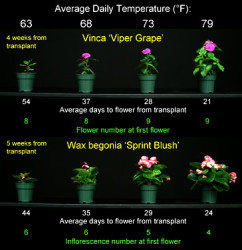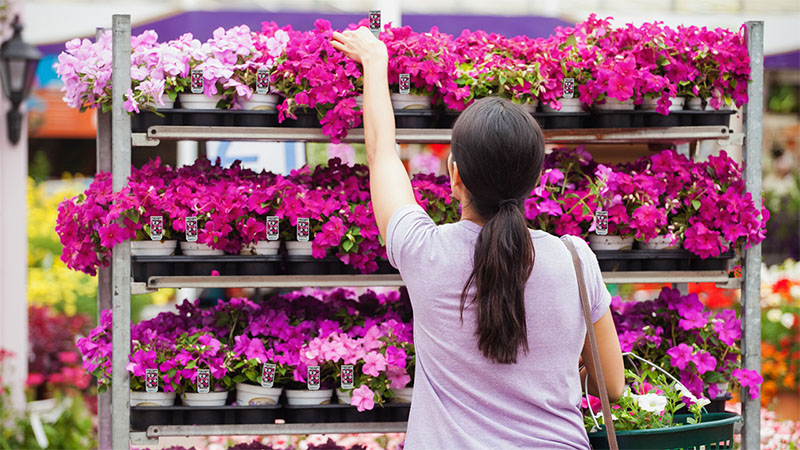Energy-Efficient Annuals: Vinca And Wax Begonia

Efficient production of bedding plants requires information on how temperature, photoperiod and daily light integral (DLI) influence crop timing and flowering characteristics. At Michigan State University (MSU), we have performed experiments with numerous seed-propagated annuals to quantify how average daily temperature and DLI influence flowering time and plant quality.
In the 10th article of this series, we present this cropping information on vinca (Catharanthus roseus) and wax begonia (Begonia semperflorens-cultorum) and then use that information with Virtual Grower to estimate greenhouse heating costs at different locations, growing temperatures and finish dates.
Materials & Methods
Seeds of vinca ‘Viper Grape’ and wax begonia ‘Sprint Blush’ were sown in 288-cell plug trays by C. Raker & Sons, then grown in controlled environmental growth chambers at MSU at a constant 68°F (20°C). Inside the chambers, the photoperiod was 16 hours and the DLI was 9 to 11 mol∙m¯²âˆ™d¯¹. This DLI is typical of that received in greenhouses in early spring in the Northern United States.
When plugs were ready for transplant (38 to 45 days after seed sow), they were transplanted into 4-inch (10-centimeter) pots and grown in greenhouses with constant temperature set points of 63, 68, 73 and 79°F (17, 20, 23 and 26°C). At each temperature, plants were grown under a 16-hour photoperiod with two different DLIs provided by sunlight, a combination of shade curtains and different supplemental lighting intensities from high-pressure sodium lamps. Vinca and wax begonia are day-neutral crops and thus, day length has no effect on flowering time.
Our experiments were performed twice to obtain average DLIs that ranged from 3.5 to 20 mol∙m¯²âˆ™d¯¹. A DLI of 3.5 mol∙m¯²âˆ™d¯¹ can be considered very low and is representative of light conditions received inside a northern greenhouse on a cloudy day in the winter. A DLI of 20 mol∙m¯²âˆ™d¯¹ can be considered moderately high and is typical for inside a greenhouse on a mid- to late spring day. The flowering date was recorded when vinca had one flower open and when wax begonia had an inflorescence with one open flower. When each plant flowered, plant height and flower bud number were recorded.
Crop timing data were used to develop mathematical models to predict flowering time and plant quality under different temperature and DLI conditions. The Virtual Grower 2.51 software (available free at VirtualGrower.net) was used to estimate the cost to heat a 21,504-square-foot greenhouse (about half an acre) to produce each crop for different finish dates and in seven locations in the U.S.
Results
In both vinca and wax begonia, time to flower decreased as average daily temperature increased from 63 to 79°F. Under a DLI of 10 mol∙m¯²âˆ™d¯¹ and at 79°F, vinca flowered 33 days earlier and wax begonia flowered 20 days earlier than plants grown under the same DLI, but at 63°F (Figure 1). The low temperature at which plant development was predicted to stop (sometimes referred to as the base temperature) was estimated to be 53°F for vinca and 43°F for wax begonia. These high base temperatures indicate wax begonia and especially vinca are cold-sensitive plants. These crops should not be grown near the base temperature because production time is significantly delayed and plants may show symptoms of chilling damage.
To illustrate the effect of temperature on vinca and wax begonia crop times, we identified dates that 288-cell plugs grown under long days would need to be transplanted for two market dates when finished under long days and a DLI of 10 mol∙m¯²âˆ™d¯¹ (Table 1).
Under low light conditions, flowering of vinca and wax begonia was slightly accelerated if the DLI was increased. For example, when DLI increased from 4 to 8 mol∙m¯²âˆ™d¯¹, time to flower at 68°F decreased by three days in vinca and six days in wax begonia. DLI had a greater influence on decreasing crop time at cooler than warmer temperatures. The estimated saturation DLI for the shortest time to flower was 8 mol∙m¯²âˆ™d¯¹ for vinca and 10.5 mol∙m¯²âˆ™d¯¹ for wax begonia. In other words, increasing the DLI above these values did not shorten crop time.
In vinca, flower number at first flowering increased as average daily temperature and DLI increased. In wax begonia, inflorescence number increased as average daily temperature decreased and as DLI increased. For example, wax begonia grown at 73°F had twice as many flowers under a DLI of 18 mol∙m¯²âˆ™d¯¹ compared with a very low DLI of 3 mol∙m¯²âˆ™d¯¹. Therefore, plant quality of both crops continued to improve with an increase in DLI, although flowering time was not accelerated beyond a DLI of 10.5 mol∙m¯²âˆ™d¯¹.
Heating Costs
The crop timing data generated in this research was used with Virtual Grower to estimate if it is more energy efficient to transplant a spring crop earlier and grow cool versus transplanting later and growing warm. To produce a finished vinca crop for April 1 in all seven locations tested (San Francisco, Calif., Tallahassee, Fla., Grand Rapids, Mich., New York, N.Y., Charlotte, N.C., Cleveland, Ohio, or Fort Worth, Texas), the least amount of energy for heating was consumed by transplanting on March 11 and growing at 79°F (Table 2). Energy costs per crop increased as temperature decreased because flowering of vinca was delayed considerably at cooler temperatures.
To produce wax begonia for April 1, the most energy-efficient production strategy for greenhouse production in Grand Rapids, New York and Cleveland was to transplant late and grow at 79°F. In contrast, we project the same crop grown in San Francisco, Tallahassee, Charlotte and Fort Worth would require less heating per crop if transplanted earlier and grown at 63 or 68 °F.
For a market date of May 15, the most energy-efficient temperature varied by location and crop. For example, vinca grown in Grand Rapids, New York, Charlotte and Cleveland would consume 11 to 56 percent less energy per crop at 73 or 79°F versus 63°F. To produce wax begonia for May 15, heating costs were predicted to be lower at a cool versus warm temperature in all locations except Grand Rapids.
We encourage you to use this crop scheduling data with Virtual Grower to determine the most energy-efficient production strategy for your location and market date. The cost of energy for heating is just one of the many production expenses for greenhouse crops. Other factors, such as the number of crop turns and overhead costs, should also be considered when choosing the most economical growing temperature for each floriculture crop producer. The impact of temperature and DLI on plant quality, and response variability among cultivars, should also be considered.










